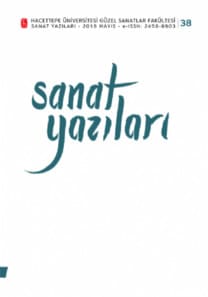GÖRÜNEN TARAFIN GÖRÜNMEYENİ (CORNELİS NORBERTUS ‘‘RESMİN TERS TARAFI’’ ESERİ ÜZERİNE)
THE UNSEEN SIDE OF WHAT IS SEEN (ON CORNELIS NORBERTUS’ WORK “THE REVERSE OF A FRAMED PAINTING”)
___
Batur, Enis. (1999). İmgeleri Kim Dinler?. İstanbul: Yapı Kredi Yayınları.Berger, John. (2008). Görme Biçimleri (Y. Salman, Çev.). İstanbul: Metis Yayınları.
Danto, Arthur. (2014). Sanatın Sonundan Sonra (Z. Demirsü, Çev.). İstanbul: Ayrıntı Yayınları.
Gombrich, Ernst Hans. (2015). İmge ve Göz (K. Atakay, Çev.). İstanbul: Yapı Kredi Yayınları.
Foster, Hal. (2009). Gerçeğin Geri Dönüşü (E. Hoşsucu, Çev.). İstanbul: Ayrıntı Yayınlar.
Foucault, Michel. (2014). Bu Bir Pipo Değildir (S. Hilav, Çev.). İstanbul: Yapı Kredi Yayınları.
Kuspit, Donald. (2010). Sanatın Sonu (Y. Tezgiden, Çev.). İstanbul: Metis Yayınları.
Kris, E. Kurz, O. (2013). Sanatçı İmgesinin Oluşumu: Efsane, Mit, Büyü (S. Gürses, Çev.). İstanbul: İthaki Yayınları.
Leppert, Richard. (2009). Sanatta Anlamın Görüntüsü (İ. Türkmen, Çev.). İstanbul: Ayrıntı Yayınları.
Maleviç, Kazimir. (2013). Nesnesiz Dünya ‘Suprematizm Manifestosu’ (F. C. Tapan, Çev.). İstanbul: Dedalus Kitap.
Sayın, Zeynep. (2013). İmgenin Pornografisi. İstanbul: Metis Yayınları.
Soysal, Ahmet. (2003). Madde ve Karanlık. İstanbul: Norgunk Yayıncılık.
Tapies, Antoni. (2014) Sanat Pratiği (İ. Birkan, Çev.). Ankara: Dost Kitapevi.
- ISSN: 2458-8903
- Yayın Aralığı: 2
- Başlangıç: 2001
- Yayıncı: -
BİLİM, MAKİNE VE SANAT: KESİŞMELER-ÇATIŞMALAR
ARMAN T. MANOOKİAN: KAYIP CENNETİN İMGESİ
GÖRÜNEN TARAFIN GÖRÜNMEYENİ (CORNELİS NORBERTUS ‘‘RESMİN TERS TARAFI’’ ESERİ ÜZERİNE)
SÜRDÜRÜLEBİLİR KAMPÜS YAKLAŞIMLARI VE TÜRKİYE’DEKİ GELİŞMELER
20. YÜZYIL SANATINDA GÜNDELİK HAYAT – SANAT İLİŞKİSİ
SERAP EMMUNGİL KARAMANOĞLU, SEMRA KÖK BALİ, GÖZDE MULLA
(POST) MODERN BİR MİT OLARAK IZGARA: EISENMAN’IN KAVRAMSAL MİMARLIĞININ BAŞI VE SONU
